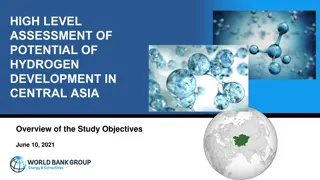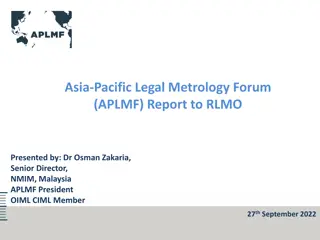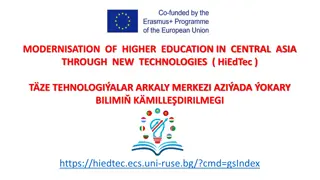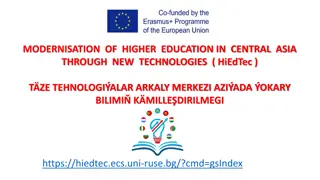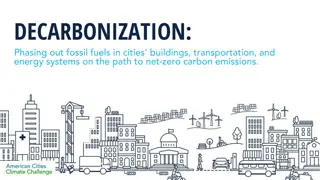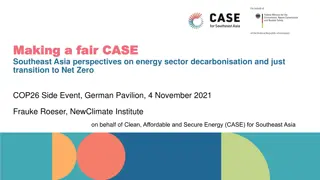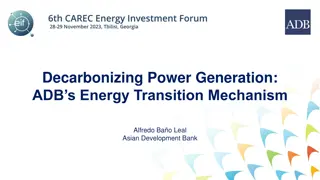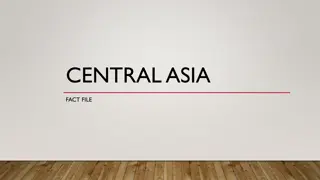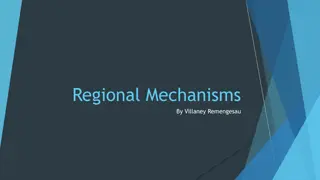Decarbonization Efforts in Central Asia: Challenges and Opportunities
Central Asia, like much of the world, is grappling with the transition to low-carbon economies and net-zero commitments. This involves overcoming reliance on fossil fuels, integrating clean energy solutions, and adopting new technologies. The region's efforts align with global goals under the Paris Agreement, with a focus on decarbonizing infrastructure and promoting renewable energy sources like wind, solar, and hydropower. Industrial development and energy efficiency are highlighted as key priorities for sustainable economic growth. The path to decarbonization in Central Asia presents both challenges and significant potential for clean energy advancements.
Download Presentation

Please find below an Image/Link to download the presentation.
The content on the website is provided AS IS for your information and personal use only. It may not be sold, licensed, or shared on other websites without obtaining consent from the author.If you encounter any issues during the download, it is possible that the publisher has removed the file from their server.
You are allowed to download the files provided on this website for personal or commercial use, subject to the condition that they are used lawfully. All files are the property of their respective owners.
The content on the website is provided AS IS for your information and personal use only. It may not be sold, licensed, or shared on other websites without obtaining consent from the author.
E N D
Presentation Transcript
The Central Asia Climate Change Conference CLIMATE CHANGE AND SECURITY: DECARBONIZATION AND ADAPTATION POLICIES FOR CENTRAL ASIA OECD recommendations for decarbonizing economies of Central Asia Monday 27 May 2024 OECD Eurasia Competitiveness Programme 1
Central Asia, much like the rest of the world, faces the question of how to get on track with low-carbon and net-zero commitments Kazakhstan Kyrgyzstan Tajikistan 400 25 18 16 350 20 14 300 12 250 15 10 200 8 10 150 6 100 4 5 50 2 0 0 0 1990 1992 1994 1996 1998 2000 2002 2004 2006 2008 2010 2012 2014 2016 2018 1990 1992 1994 1996 1998 2000 2002 2004 2006 2008 2010 2012 2014 2016 2018 1990 1992 1994 1996 1998 2000 2002 2004 2006 2008 2010 2012 2014 2016 2018 Turkmenistan Uzbekistan 250 140 120 200 100 150 80 60 100 40 50 20 0 0 1990 1992 1994 1996 1998 2000 2002 2004 2006 2008 2010 2012 2014 2016 2018 1990 1992 1994 1996 1998 2000 2002 2004 2006 2008 2010 2012 2014 2016 2018 All Central Asia countries have joined the global effort to bring about a drastic reduction of GHG emissions under the Paris Agreement Two have formally committed to net-zero by mid-century Getting on track with these objectives will require substantial effort 2 Decarbonising infrastructure will be critical
Getting on track will require to overcome reliance on fossil fuels, enable a clean energy transition and adopt new techniques and technologies CO2 intensity of economic output, USD PPP per KG CO2-e Reliance on fossil fuels is a key challenge to the low-carbon transition in much of the region OECD CA weighted average EESC weighted average 6 5 4 There is high potential for wind and solar development and most Eurasia countries have established targets to increase RE shares in their energy mixes, which remain low overall 3 2 1 0 Central Asia countries are also looking into the potential of hydropower Total energy supply by source, TJ Kazakhstan Kyrgyzstan Industrial development remains a priority for economic development Tajikistan Energy efficiency and low carbon technologies need to be adopted and scaled up across industrial sectors Turkmenistan Uzbekistan 0 10 20 30 40 50 60 70 80 90 100 Coal Natural gas Hydro Oil Biofuels and waste Wind, solar, etc. 3
Benefits of decarbonisation in Central Asia Reducing GHG emissions and reaching NDC targets under the Paris Agreements Reducing pollution and enhancing health outcomes and quality of life across the region Enhance the productivity and competitiveness of Central Asia economies through higher energy efficiency Creating new economic opportunities through green innovation, the development of low-carbon products and services, adjusting to new trade conditions and moving-up value chains on the backdrop of higher regional integration and connectivity developments with external markets Opportunity to enhance the management of the water sector Protecting the biodiversity 4
SIPAs framework for decarbonising infrastructure 2. ENABLING POLICIES IN ENERGY, TRANSPORT, INDUSTRY Decarbonising strategies Clean energy finance and investment Greening industries 1. PLANNING Long-term strategy Project-level evaluation Implementationpartners: Technical Technical assistance, policy assistance, policy dialogues and dialogues and capacity building in capacity building in four transformative four transformative areas areas 3. MOBILISING FINANCIERS AND BUSINESSES Sustainable finance principles Due diligence for responsible business conduct 4. REGIONAL AND INTERNATIONAL PEER LEARNING Regional policy network Regional trainings 5
LT-LEDS are powerful tools for integrating long-term economic development and low-carbon transition planning Country Status Year of Adoption Submitted to UNFCCC Adopted Announced None None 2023 No No No No Kazakhstan Kyrgyzstan Tajikistan Turkmenistan - - - To be adopted soon No Uzbekistan - Under Development No Mongolia - Three out of five Central Asia countries have adopted or are adopting LT-LEDS, which are powerful tools for integrating long-term economic growth and low carbon transition planning If associated with strong commitments (notably with regards to carbon pricing), the adoption of robust LT-LEDS can help align stakeholders across economies and encourage innovation and investment plans aligned with low-carbon transitions The development and implementation of LT-LEDS require effort and commitment, and are supported by international partners 6
Example of low-carbon technology development in Central Asia: Green Hydrogen why it is an opportunity Hydrogen will play an important role in achieving net zero due to its ability to support the decarbonisation of hard-to-abate sectors. B. Scenarios of global hydrogen demand in 2050 Hydrogen in TFC (EJ) A. Sources of emission reductions in Net Zero scenarios Other fuel shifts CCUS EJ % of TFC Share of TFC 120 25% 100% 90% 100 20% 80% 70% 80 15% 60% 60 Central Asia governments have plans for developing industrial bases. 50% 10% 40% 40 30% 5% 20% 20 10% 0 0% 0% Electrification (RE) will play an important role in industrial decarbonisation, but new technologies many in a low level of technological and commercial readiness will be required in some sectors. C. Global energy sector CO2 emissions reductions by measure in the Sustainable Development Scenario relative to the Stated Policies Scenario Avoided demand Hydrogen Bioenergy Other renewables Electrification Other fuel shifts Technology performance CCUS GtCO2 per year 0 -5 Green hydrogen can have applications in hard-to-abate industries including the mining sector -10 -15 -20 -25 -30 Large-scale projects are being developed in Kazakhstan and Uzbekistan -35 -40 2020 2025 2030 2035 2040 2045 2050 2055 2060 2065 2070 7
Example of low-carbon technology development in Central Asia: Green hydrogen technology transfer Enabling transfer of knowledge, technology and capacities between STI system and industry International co-operation Domestic mechanisms Example of Japan s Joint Crediting Mechanism (JCM) Japanese mechanism to facilitate diffusion of leading decarbonisation technologies, products, services, infrastructure, etc. Allows offsetting of Japan s GHG emission reductions in line with NDC commitments E.g. Mongolia is a partner country of the JCM, existing JCM projects in the country; Renewable hydrogen projects in Mongolia soliciting JCM Allows a 30% grant (up to a ceiling) to cover the purchase of equipment from Japanese technology providers where this enables local emissions reduction Technology transfer units within higher education and public research; Giving HEIs tech transfer mandate Industry-research partnerships; Public funding to target country-specific H2 challenges; Awareness raising in industry of renewable H2 applications. 8
Example of low-carbon technology development in Central Asia: Green Hydrogen the hydrogen-water nexus: insights from Mongolia Water demand of a potential renewable hydrogen sector versus other user sectors in Mongolia Recommendations for Mongolia Anticipate, monitor and develop metrics and standards for H2 water needs Local renewable H2 project Phase I 44 Local renewable H2 project Phase III Embed water innovation in STI and investment framework for H2 (e.g. incentives, approvals etc.) 580 Renewable H2 - 1 MT 29,018 Consider cross-sectoral co-operation with a focus on wastewater use Mining in South Gobi - 2030e 31,209 Enhance water policy framework: Cross-sectoral co-ordination and institutional capabilities (RBOs) Multi-stakeholder dialogue incl. through EIAs Water data and management (groundwater) Water tariff system revision Mainstream needs and risks into future water infrastructure plans Household consumption - 2022 86,380 Total mining - 2022 92,540 Agriculture - 2022 338,600 Total - 2022 606,200 0 200,000 400,000 600,000 800,000 9
Conclusion: green hydrogen within the SIPA framework LT-LEDS can help articulate the contribution of hydrogen to the economy-wide decarbonisation pathway Enabling technology in decarbonisation pathways of key sectors for CA economies Should integrate broader environmental considerations: e.g. SEA and EIA use Framework conditions for decarbonising infrastructure apply to hydrogen (and other low-carbon technologies): investment policy framework, effective carbon pricing measures Sector- and technology-specific measures also relevant (e.g. directed tax breaks) 2. ENABLING POLICIES IN ENERGY, TRANSPORT, INDUSTRY 1. PLANNING 3. MOBILISING FINANCIERS AND BUSINESSES 4. REGIONAL AND INTERNATIONAL PEER LEARNING Cross-border co-operation is critical for enabling technology transfer, securing financing including private investment and adopt standards and good practices Regional co-operation among Central Asia countries needed to learn, foster opportunities and address shared challenges, e.g. water Critical to directing investment in hydrogen as well as other low-carbon technologies Aligning on taxonomies and reporting systems will be pivotal 10
Thank you ! peline.atamer@oecd.org 1 1




